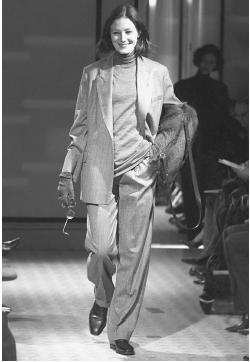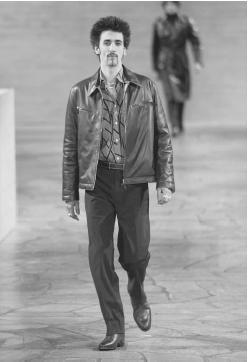HERMÉS - Fashion Designer Encyclopedia
French design house
Founded: in Paris by Thierry Hermés in 1837 to manufacture bridles, saddles, and riding boots for the carriage trade. Company History: Company moved to rue de Faubourg in Paris, 1879; began accessories, including silk scarves, 1926; founder's grandson, Emile Hermés, established luggage and couture clothing in 1930s; Hermés scarf introduced, 1937; silk ties first sold, 1949; first fragrances, 1950 (later including Caleche, 1961; 24, Faubourg, 1995, and Hermés Rouge, 2001); glassware, tableware introduced, 1980s; initial public offering, 1993; Martin Margiela appointed ready-to-wear designer, 1997; purchases 35-percent stake in Jean-Paul Gaultier's design business, 1999; opened Madison Avenue store, New York, 2000. Company Address: 24 rue du Faubourg Saint-Honoré, 75008 Paris, France.


Publications
By HERMÉS:
Books
Hermés Handbook, New York, n.d.
How to Wear Your Hermés Scarf, Paris, 1986, 1988, 1994.
Baseman, Andrew, The Scarf, New York, 1989.
Hermés: Le Monde d'Hermés 1992, Paris, 1991.
On HERMÉS:
Books
Hermés Handbook, New York n.d.
Keller-Krische, Christiane, The Book of Scarves: Scarves, Shawls, and Ties Dressed with Imagination, 2000.
Articles
"A Boutique Where You Don't Just Buy—You Invest," in Vogue, October 1974.
Van Dyke, Grace, "Hermés: Old World Luxury in the New World," in USA Today, July 1984.
Dryansky, G.Y., "Hermés: Quality with a Kick," in Harper's Bazaar, April 1986.
"Scarves Everywhere," in the New Yorker, 30 January 1989.
Aillaud, Charlotte, "The Hermés Museum: Inspiration for the Celebrated Family Firm," in Architectural Digest, January 1989.
Beckett-Young, Kathleen, "Signature in the Social Register," in Connoisseur, June 1989.
Tompkins, Mimi, "Sweatshop of the Stars," in U.S. News & World Report, 12 February 1990.
Gandee, Charles, "Jean-Louis Dumas—Hermés is Flying High," in House & Garden, August 1990.
Hornblower, Margaret, "As Luxe as It Gets," in Time, 6 August 1990.
"Hermés: Still in the Saddle," in WWD, 25 September 1991.
"Hermés of Paris, Inc.," in the New York Times, 5 October 1991.
Andrieu, Frederic, "European Accents: A Gold Brooch Here, a Quilted Bag There, and Hermés Scarves Everywhere…," in Lear's (New York), January 1992.
Slesin, Susan, "Ah, the Horse: Hermés Introduces New Porcelain Pattern," in the New York Times, 21 May 1992.
Rotenier, Nancy, "Tie Man Meets Queen of England," in Forbes, 13September 1993.
Morris, Bernadine, "Five Designers Reveal a Sense of Calm in Paris," in the New York Times, 10 March 1994.
White, Constance C.R., "Hermés Seeks a New Image," in the New York Times, 20 March 1995.
Mead, Rebecca, "The Crazy Professor: Why was Paris Persuaded that the Radical Martin Margiela was Right for the Venerable House of Hermés?" in the New Yorker, 30 March 1998.
Strom, Stephanie, "Luxury in Recession Land; the Hermés of the World Find New Ways to Prosper in Japan's Weak Economy," in the New York Times, 29 October 1998.
Thomas, Dana, "Gaultier Goes for Growth," in the Newsweek International, 19 July 1999.
"Time and Again: Hermés Opens Boutique on Madison Avenue…," in Elle, December 2000.
Taber, Andrew, "Hermés," [profile] available online at Fashion Live, www.fashionlive.com , 19 March 2001.
***
Emile-Maurice Hermés, grandson of founder Thierry Hermés, summed up the philosophy of his family's celebrated firm in the 1920s as "Leather, sport, and a tradition of refined elegance." Passed down over generations, the House of Hermés has been committed to quality in design and production for more than 160 years. At the dawn of the 21th century, the name Hermés continues to represent the ultimate in French luxury.
Hermés began as a Parisian leather goods shop in 1837, making finely wrought harnesses, bridles, and riding boots for the carriage trade. As early as 1855 Hermés was earning accolades, winning first prize in its class at the 1855 Paris Exposition. Thierry's son Emile-Charles established the current flagship store at 24 rue du Faubourg Saint-Honoré, where he introduced saddlery and began retail sales. Emile-Charles sold his stake in the company to his brother, Emile Maurice, who in turn was the true visionary of the Hermés family.
With the advent of the automobile, the firm adapted its careful saddle stitching techniques to the production of wallets, luggage, handbags, watchbands, and accessories for golfing, hunting, and polo playing, and began to design couture sportswear. All were made with the same fine materials and attention to detail as the original leather wares, and the firm continued to build on its reputation for quality. Hermés made fashion news in the 1920s by designing one of the first leather garments of the 20th century, a zippered golfing jacket, for the Prince of Wales. For a time the zipper was called the fermature Hermés, because of its European impact (Emile-Maurice had bought a two-year patent on the unusual Canadian invention).
The fourth generation of proprietors were two sons-in-law, Jean Guerrand and Robert Dumas. Guerrand and Dumas added scarves and perfume to the line, while the leather artisans remained loyal, often staying on for decades. Into the 1960s the company continued to expand, with the introduction of new styles and fragrances. Jean-Louis Dumas, the son of Robert Dumas, became président-directeur général in 1978.
The 1980s were a period of unprecedented growth for the firm. Hermés benefitted from the revival of status dressing. Women sported the crocodile-skin Kelly bag (named for Grace Kelly), the Constance clutch, brightly colored leathers, sensuous cashmeres, bold jewelry, tricolored spectator shoes, and silk ballet slippers. For men, Hermés made leather jackets with sherpa lining and trim, gabardine blazers and dashing greatcoats, and richly patterned silk ties. Dumas introduced new materials like porcelain and crystal, expanding the line to some 30,000 items. It is to the firm's credit that they have never licensed any of their products, but keep tight control over the design and manufacture of this vast range of goods. Thus every leather-bound datebook, porcelain teapot, silk waistcoat, scarf, and handbag is made under a watchful Hermés eye.
One of the most visible and bestselling items in the Hermés line is the scarf, or carré as they are called. The carefully printed, heavy silk scarves are coveted for the air of Parisian style they impart. Many of the carrés feature equestrian motifs, as well as other symbols of prestige, like coats of arms, banners, and military insignia. Women boast of how many they own, and hand them down through generations; some of the scarves end up as framed wall-hangings or are made into pillows. The firm corresponds regularly with Hermés addicts trying to collect every scarf on the books, and reports that during the holiday season in the Paris store, a scarf is sold every 20 seconds. Queen Elizabeth II was pictured on an English postage stamp with an Hermés scarf wrapped around her royal head. Each scarf could be considered a small symbol of all of the carefully made luxury goods Hermés has produced for generations.
Hermés, rarely one to keep pace with trends, astonished the fashion world with the appointment of decontructionist Martin Margiela as its ready-to-wear designer in 1997. The Dutch eccentric, known for his savage avant-garde designs—often literally ripping the seams of garments and haphazardly stitching them back together—proved an excellent albeit bizarre fit. The first Margiela collection debuted in March 1998 and was well received. Andrew Taber, writing for Fashion Live, found the collection "quietly subversive" and further commented, "Margiela's sweeping camel coats and unstructured layers of cashmere and deerskin were timeless, serene, and utterly luxurious in their lack of ostentation."
Though many had their doubts when Jean-Louis Dumas brought Margiela into the Hermés fold, the designer brought a hint of radicalism into the lap of conservative luxury. Another move into the fashion left came with the purchase in 1999 of a 35-percent stake in Gaultier Couture, the company of fashion bad boy Jean-Paul Gaultier. Gaultier got funds for expansion; Hermés extended its empire to keep up with luxe conglomerates like LVMH. Yet the recent additions of Gaultier and Margiela far from tarnished the Hermés name; the company's clothing and accessories have continued to transcend fashion. The Hermés look relies not on trends but on the finest materials, exquisite construction, and the instinctively casual chic of French style.
Over the course of the 20th century and into the 21st, the cut of the clothing and the palettes may have changed, but the classic quality of Hermés designs have remained constant. Beyond mere status symbols, the firm's goods are the embodiment of simplicity and elegance in extremely well made and durable products. Whether it be a jacket of meltingly soft leather, a paisley silk dressing gown, a Kelly bag, a valise, or a carré , an Hermés purchase comes with the assurance that it will be stylish and appropriate for a lifetime. With more than 215 Hermés stores around the world and countless boutiques in high-end department stores in Europe, Asia, and the U.S., the Hermés name has certainly gained more prominence, but its goods land not in the hands of the masses but in the chosen few.
—Kathleen Paton;
updated by Nelly Rhodes
Comment about this article, ask questions, or add new information about this topic: